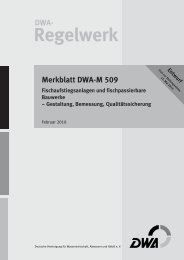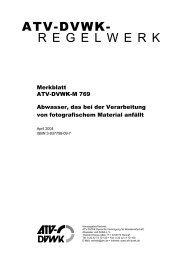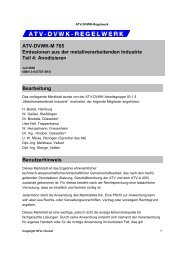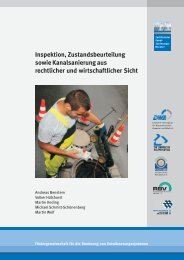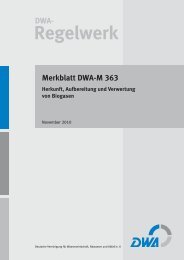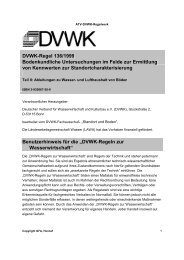Dynamic Cost Comparison Calculations for selecting least-cost ...
Dynamic Cost Comparison Calculations for selecting least-cost ...
Dynamic Cost Comparison Calculations for selecting least-cost ...
Create successful ePaper yourself
Turn your PDF publications into a flip-book with our unique Google optimized e-Paper software.
<strong>Dynamic</strong> <strong>Cost</strong> <strong>Comparison</strong><br />
<strong>Calculations</strong> <strong>for</strong> <strong>selecting</strong> <strong>least</strong>-<strong>cost</strong><br />
projects in Water Supply and<br />
Wastewater Disposal<br />
DCCC - Appraisal Manual <strong>for</strong> Project<br />
Designers<br />
December 2011<br />
Arbeitsanleitung zur Durchführung dynamischer Kostenvergleichsrechnungen<br />
für Projektplanungen in der Siedlungswasserwirtschaft
DCCC Appraisal Manual<br />
The German Association <strong>for</strong> Water, Wastewater and Waste (DWA) is strongly committed to the development of secure and<br />
sustainable water and waste management. As a politically and economically independent organisation it is professionally<br />
active in the field of water management, wastewater, waste and soil protection.<br />
In Europe DWA is the association with the largest number of members within this field. There<strong>for</strong>e it takes on a unique position in<br />
connection with professional competence regarding standardisation, professional training and in<strong>for</strong>mation. The approximately<br />
14,000 members represent specialists and executives from municipalities, universities, engineering offices, authorities and<br />
companies.<br />
Imprint<br />
Publisher and marketing:<br />
DWA German Association <strong>for</strong><br />
Water, Wastewater and Waste<br />
Theodor-Heuss-Allee 17<br />
53773 Hennef, Germany<br />
Tel.:<br />
Fax:<br />
E-Mail:<br />
Internet:<br />
+49 2242 872-333<br />
+49 2242 872-100<br />
info@dwa.de<br />
www.dwa.de<br />
Translation:<br />
Helga Schlag, Bottrop<br />
Printing (English version):<br />
DWA<br />
ISBN:<br />
978-3-941897-05-2<br />
The translation was sponsored by the<br />
German Federal Environmental Foundation (DBU).<br />
Printed on 100 % recycled paper<br />
© DWA Deutsche Vereinigung für Wasserwirtschaft, Abwasser und Abfall e. V., Hennef 2011<br />
German Association <strong>for</strong> Water, Wastewater and Waste<br />
All rights, in particular those of translation into other languages, are reserved. No part of this publication may be reproduced in any <strong>for</strong>m –<br />
by photocopy, digitalisation or any other process – or transferred into a language usable in machines, in particular data processing<br />
machines, without the written approval of the publisher.<br />
2 DWA 2011
Preface<br />
DCCC Appraisal Manual<br />
Ensuring value <strong>for</strong> money in public utility management, by following the principle of economic efficiency and <strong>cost</strong> consciousness,<br />
has always been a pivotal point <strong>for</strong> the water sector. This so in particular in the face of today's controversial<br />
situation as regards the need <strong>for</strong> development, extension, and rehabilitation of the country's water and waste water<br />
infrastructure. On the one hand, public resources available <strong>for</strong> the purpose are very limited, and, on the other hand, EU<br />
funding programmes pose a real challenge to the <strong>cost</strong>-consciousness and carefulness of decision makers working at local<br />
and regional level. Good results can only be achieved if the proposed measures are reviewed and compared critically on<br />
the basis of transparent, professionally-comprehensible and reliable planning approaches. This will help enhance the<br />
overall decision finding process. Today's modern planning tools make it possible to prepare, in a systematic and traceable<br />
way, all relevant documents needed by the decision makers in the water industry to explore the iron triangle time<strong>cost</strong>-quality<br />
and to select the best-suited, most <strong>cost</strong>-effective and sustainable solution.<br />
This manual is an adopted version based on German standards, as documented in the regularly updated 'Guidelines <strong>for</strong><br />
the Application of <strong>Dynamic</strong> <strong>Cost</strong> <strong>Comparison</strong> <strong>Calculations</strong>' (DCCC-Guidelines). For no less than 30 years, the German<br />
Working Group on Water Issues of the Federal States and the Federal Government (LAWA) have supported the water<br />
sector by defining, revising and publishing such tools, starting with the manual’s first edition in 1986 and ending with<br />
the seventh edition in 2005. From that date on, DWA, the German Association <strong>for</strong> Water, Wastewater and Waste, as a<br />
licensee, has taken over responsibility <strong>for</strong> these activities.<br />
Within the framework of the cooperation between DWA and several national water associations from Southeast Europe the<br />
idea was born to transfer German specialised knowledge in project design and delivery by working out an internationalised<br />
English version of the DCCC-Guidelines and by furthering their implementation and application in customized versions that<br />
would be in line with national specifics. To this end, DWA has launched a practice-oriented project with the financial support<br />
of the German Federal Environmental Foundation, DBU (Deutsche Bundesstiftung Umwelt). Participating countries are<br />
Bulgaria, Croatia, Hungary, Romania, and Slovakia. The project consists of two parts or phases. In Part I, the basis of the<br />
User's Manual was set up during a one-week workshop at DWA’s headquarters in Hennef and another three-day workshop<br />
in Munich, then a draft was prepared, approved and released <strong>for</strong> translation into the different national languages.<br />
In Part II, DWA will then support the implementation and application processes, especially those required to obtain acceptance<br />
by both the EU and the national institutions involved. DWA will also help with capacity building. National<br />
workshops will be held by the local water associations to communicate in<strong>for</strong>mation to all partners involved in the countries’<br />
water supply and wastewater disposal industry in how to use the manual most effectively.<br />
Senior experts from the above mentioned countries have participated in the process of putting in place and publishing<br />
the DCCC-Guidelines <strong>for</strong> water infrastructure projects. All relevant issues have been incorporated in a clear and concise<br />
<strong>for</strong>m which includes a number of real world examples. This makes it easier <strong>for</strong> project planners to apply the proposed<br />
methods and to choose between alternative solutions. The manual will not only serve as a practical guide <strong>for</strong> investors,<br />
beneficiaries, technical designers, and financial planners, controlling institutions, investment banks, local and regional<br />
authorities, but also as a core tool <strong>for</strong> those parties participating in EU tendering processes, because its application in<br />
feasibility studies provides all in<strong>for</strong>mation on <strong>cost</strong> and efficiency data needed <strong>for</strong> proving that the selected project is the<br />
most suitable alternative between the decision-relevant options.<br />
The manual shall support the relevant institutions in Bulgaria, Croatia, Hungary, Romania, Slovakia and other countries<br />
with the realisation and introduction of suitable work instructions <strong>for</strong> infrastructure projects on the water supply and<br />
wastewater disposal sector. As normative targets have to be met in this field, application of the <strong>cost</strong> comparison method<br />
is a recommended approach in order to find the most <strong>cost</strong>-effective option and to achieve the required results in a verifiable<br />
and justifiable way. In addition, implementation of the User’s Manual will provide the data bases <strong>for</strong> application of<br />
EU-subsidies to conduct economic and financial analyses in good accordance with the general philosophy of the European<br />
Commission, CBA-Guidance (2008).<br />
I should like to thank all those who contributed to bringing the User’s Project Appraisal Manual to life.<br />
Planegg, September 2011<br />
Professor Dr.-Ing. Reinhard F. Schmidtke<br />
Chairperson of the Working Group<br />
DWA 2011 3
DCCC Appraisal Manual<br />
Participants of the International Working Group<br />
Chairperson<br />
SCHMIDTKE Prof. Dr.-Ing.,<br />
Reinhard F.<br />
Co-Chairperson<br />
Bertha-von-Suttner-Weg 10, 82152 Planegg, Germany<br />
Consultant to DWA German Association <strong>for</strong> Water, Wastewater and Waste<br />
Formerly: Technical University Darmstadt and Bavarian Agency <strong>for</strong> Water Management<br />
KOVÁCS, Károly Higany u. 15, 1118 Budapest, Hungary<br />
Vice President of the Hungarian Wastewater Association (MASZESZ),<br />
Management Committee Member of the European Water Association (EWA)<br />
Members<br />
CVACI, Dr.-Ing., Darius COPLAN CAI SRL<br />
Str. Virgiliu 17-19, Sector 1, 010881, Romania<br />
CZEGLÉDI, Ildiko ÖKO Zrt.<br />
Attila út 16, 1013 Budapest, Hungary<br />
DASKALOV, Theodor Utilities Services Ltd.<br />
Angel Kanchev Str. 2, 1000 Sofia, Bulgaria<br />
FILIPOVIC, Branimir Croatian Water Pollution Control Society<br />
Ulica grada Vukovara 220, 10000 Zagreb, Croatia<br />
FÜSTÖS, András BDL Environmental Ltd.<br />
Tárogato Str. 14, 1021 Budapest, Hungary<br />
HORNAKOVA, Andrea Water Research Institute<br />
Nabrz. Arm. Gen. L Svobodu 5, 81249 Bratislava, Slovakia<br />
KALCHEVA, Kalina Aquapartner Ltd.<br />
58, Damjan Gruew Str., 1606 Sofia, Bulgaria<br />
KLEINERTOVA, Janka Larive Slovakio s.r.o.<br />
Heydukova 5, 81108 Bratislava, Slovakia<br />
PINTER, Marija Ministry of Regional Development, Forestry and Water Management<br />
Ulica grada Vukovara 220, 10000 Zagreb, Croatia<br />
RACELESCU, Radu Aquatim<br />
Gh. Lazar Nr. 11A, Timisoara, Romania<br />
SAMARJAY, Zoltan Radlinskeho 30, 81107 Bratislava, Slovakia<br />
VARGA, Balázs Ministry of Environment and Water Development Directorate<br />
Váci út 45, 1134 Budapest, Hungary<br />
VASILESCU, Ileana Ministry of Environment and Forests<br />
12, Libertatii Blvd, Sector 5, 040128 Bucharest, Romania<br />
VATRALOVA, Albena Department of Water Management and Usage (<strong>for</strong>merly IWP-BAS)<br />
National Institute of Meteorology and Hydrology (NIMH-BAS)<br />
66 Tzarigradsko Shosee Boul., 1784 Sofia, Bulgaria<br />
ZBASNIK, Snjezana Hrvatske vode<br />
Ulica grada Vukovara 220, 10000 Zagreb, Croatia<br />
Contact person to German Federal Environmental Foundation (DBU)<br />
DOMEL, Claudia Fraunhofer Center <strong>for</strong> Central and Eastern Europe<br />
Städtisches Kaufhaus Leipzig, Neumarkt 9-19, 04109 Leipzig, Germany<br />
Coordination<br />
MARTENS, Gabriele DWA German Association <strong>for</strong> Water, Wastewater and Waste<br />
Theodor-Heuss-Allee 17, 53773 Hennef, Germany<br />
4 DWA 2011
Contents<br />
DCCC Appraisal Manual<br />
Preface ................................................................................................................................................................ 3<br />
Participants of the International Working Group ................................................................................................... 4<br />
List of Figures ........................................................................................................................................................... 9<br />
List of Tables ............................................................................................................................................................ 10<br />
1 Objectives and instruments ................................................................................................................... 11<br />
1.1 Purpose and rationale .............................................................................................................................. 11<br />
1.2 Instrumental and methodical limits .......................................................................................................... 12<br />
2 Methodology ........................................................................................................................................... 15<br />
2.1 Preliminaries ............................................................................................................................................ 16<br />
2.2 <strong>Cost</strong> comparison in the strict sense of the term ........................................................................................ 16<br />
2.2.1 <strong>Cost</strong> finding ............................................................................................................................................. 16<br />
2.2.2 Conversion of <strong>cost</strong> items .......................................................................................................................... 17<br />
2.2.3 <strong>Comparison</strong> of <strong>cost</strong> present values and annual <strong>cost</strong>s, respectively ............................................................ 17<br />
2.2.4 Sensitivity analyses and determination of break-even points .................................................................... 17<br />
2.2.5 Overall assessment and interpretation of results ...................................................................................... 17<br />
3 <strong>Cost</strong> finding ............................................................................................................................................ 18<br />
3.1 <strong>Cost</strong> types ................................................................................................................................................ 18<br />
3.1.1 Investment and running <strong>cost</strong>s .................................................................................................................. 19<br />
3.1.2 Other terms and itemisation of <strong>cost</strong>s ........................................................................................................ 19<br />
3.2 Compilation and calculation of <strong>cost</strong>s ........................................................................................................ 20<br />
3.2.1 Methods of <strong>cost</strong> finding ............................................................................................................................ 20<br />
3.2.2 Requirements <strong>for</strong> <strong>cost</strong> comparisons .......................................................................................................... 21<br />
3.3 Consideration of price developments ....................................................................................................... 22<br />
3.3.1 Principle of evaluation in real terms ......................................................................................................... 22<br />
3.3.2 Updating of <strong>cost</strong> data ............................................................................................................................... 23<br />
3.3.3 Considering future real price changes ...................................................................................................... 25<br />
4 <strong>Cost</strong> conversions into equivalent terms ................................................................................................ 26<br />
4.1 Fundamentals .......................................................................................................................................... 26<br />
4.2 Period of analysis ..................................................................................................................................... 27<br />
4.3 Interest rate ............................................................................................................................................. 28<br />
4.4 Temporal weighting of <strong>cost</strong>s .................................................................................................................... 29<br />
4.4.1 Conversion of individual <strong>cost</strong>s into present values ................................................................................... 29<br />
4.4.2 Conversion of individual <strong>cost</strong> items into uni<strong>for</strong>m <strong>cost</strong> series .................................................................... 31<br />
4.4.3 Conversion of uni<strong>for</strong>m <strong>cost</strong> series into present values .............................................................................. 33<br />
4.4.4 Conversion of progressively increasing <strong>cost</strong> series into <strong>cost</strong> present values .............................................. 34<br />
5 <strong>Comparison</strong> of <strong>cost</strong> present values and annual <strong>cost</strong>s .......................................................................... 36<br />
5.1 Overview .................................................................................................................................................. 36<br />
5.2 Simple comparison of project <strong>cost</strong> present values and annual <strong>cost</strong>s ......................................................... 37<br />
5.3 <strong>Comparison</strong> of equivalent project <strong>cost</strong> present values .............................................................................. 39<br />
5.4 <strong>Comparison</strong> of the temporal development of project <strong>cost</strong> present values ................................................. 42<br />
DWA 2011 5
DCCC Appraisal Manual<br />
6 Sensitivity analyses and determination of critical values .................................................................... 45<br />
6.1 General .................................................................................................................................................... 45<br />
6.2 Explanatory examples .............................................................................................................................. 46<br />
6.3 Determination of dynamic prime <strong>cost</strong>s ..................................................................................................... 49<br />
6.3.1 Methodology ............................................................................................................................................ 49<br />
6.3.2 Numerical example .................................................................................................................................. 50<br />
7 Overall assessment and result interpretation ....................................................................................... 54<br />
Appendix ................................................................................................................................................................ 55<br />
Summary of contents ................................................................................................................................................. 55<br />
Annex 1 Average service lifetimes of facilities in hydraulic engineering .......................................................... 56<br />
Preliminary remarks ................................................................................................................................................... 56<br />
Annex 2 <strong>Cost</strong> Conversion Factors ................................................................................................................. 66<br />
Annex 2.1-1 Accumulation factor <strong>for</strong> individual <strong>cost</strong> items AFACIC(i;n) ............................................................... 68<br />
Annex 2.1-2 Accumulation factor <strong>for</strong> individual <strong>cost</strong> items AFACIC(i;n) ............................................................... 69<br />
Annex 2.2-1 Discounting factor <strong>for</strong> individual <strong>cost</strong> items DFACIC(i;n) .................................................................. 70<br />
Annex 2.2-2 Discounting factor <strong>for</strong> individual <strong>cost</strong> items DFACIC(i;n) .................................................................. 71<br />
Annex 2.3-1 Capital recovery factor CRFAC(i;n) ................................................................................................... 72<br />
Annex 2.3-2 Capital recovery factor CRFAC(i;n) ................................................................................................... 73<br />
Annex 2.4-1 Accumulation factor <strong>for</strong> uni<strong>for</strong>m <strong>cost</strong> series AFACS(i;n) ................................................................... 74<br />
Annex 2.4-2 Accumulation factor <strong>for</strong> uni<strong>for</strong>m <strong>cost</strong> series AFACS(i;n) ................................................................... 75<br />
Annex 2.5-1 Discounting factor <strong>for</strong> uni<strong>for</strong>m <strong>cost</strong> series DFACS(i;n) ...................................................................... 76<br />
Annex 2.5-2 Discounting factor <strong>for</strong> uni<strong>for</strong>m <strong>cost</strong> series DFACS(i;n) ...................................................................... 77<br />
Annex 2.6.1-1 Discounting factor <strong>for</strong> series progression DFACSP(0,5;i;n) increase rate r = 0,5 % p. a. ......... 78<br />
Annex 2.6.1-2 Discounting factor <strong>for</strong> series progression DFACSP(0,5;i;n) increase rate r = 0,5 % p. a. ......... 79<br />
Annex 2.6.2-1 Discounting factor <strong>for</strong> series progression DFACSP(1;i;n) increase rate r = 1 % p. a. ............ 80<br />
Annex 2.6.2-2 Discounting factor <strong>for</strong> series progression DFACSP(1;i;n) increase rate r = 1 % p. a. ............ 81<br />
Annex 2.6.3-1 Discounting factor <strong>for</strong> series progression DFACSP(1,5;i;n) increase rate r = 1,5 % p. a. ......... 82<br />
Annex 2.6.3-2 Discounting factor <strong>for</strong> series progression DFACSP(1,5;i;n) increase rate r = 1,5 % p. a. ......... 83<br />
Annex 2.6.4-1 Discounting factor <strong>for</strong> series progression DFACSP(2;i;n) increase rate r = 2 % p. a ............ 84<br />
Annex 2.6.4-2 Discounting factor <strong>for</strong> series progression DFACSP(2;i;n) increase rate r = 2 % p. a. ............ 85<br />
Annex 2.6.5-1 Discounting factor <strong>for</strong> series progression DFACSP(2,5;i;n) increase rate r = 2,5 % p. a. ......... 86<br />
Annex 2.6.5-2 Discounting factor <strong>for</strong> series progression DFACSP(2,5;i;n) increase rate r = 2,5 % p. a. ......... 87<br />
Annex 2.6.6-1 Discounting factor <strong>for</strong> series progression DFACSP(3;i;n) increase rate r = 3 % p. a. ............ 88<br />
Annex 2.6.6-2 Discounting factor <strong>for</strong> series progression DFACSP(3;i;n) increase rate r = 3 % p. a. ............ 89<br />
Annex 2.6.7-1 Discounting factor <strong>for</strong> series progression DFACSP(3,5;i;n) increase rate r = 3,5 % p. a. ......... 90<br />
Annex 2.6.7-2 Discounting factor <strong>for</strong> series progression DFACSP(3,5;i;n) increase rate r = 3,5 % p. a. ......... 91<br />
Annex 2.6.8-1 Discounting factor <strong>for</strong> series progression DFACSP(4;i;n) increase rate r = 4 % p. a. ............ 92<br />
Annex 2.6.8-2 Discounting factor <strong>for</strong> series progression DFACSP(4;i;n) increase rate r = 4 % p. a. ............ 93<br />
Annex 3 Project examples to explain the methodical approaches .............................................................. 94<br />
Preliminary note ........................................................................................................................................................ 94<br />
6 DWA 2011
DCCC Appraisal Manual<br />
Project example 1 ..................................................................................................................................................... 95<br />
Wastewater disposal by a gravity sewerage system or by a pressure sewerage system ............................................... 95<br />
1 Project definition .................................................................................................................................... 95<br />
2 Description of project alternatives ........................................................................................................ 95<br />
3 Applicability of the <strong>cost</strong> comparison method ....................................................................................... 95<br />
4 <strong>Cost</strong> finding ............................................................................................................................................ 95<br />
5 Calculation of <strong>cost</strong> present values and annual <strong>cost</strong>s ............................................................................ 97<br />
5.1 Calculation parameters ............................................................................................................................ 97<br />
5.2 <strong>Cost</strong> conversion ........................................................................................................................................ 97<br />
6 <strong>Comparison</strong> of <strong>cost</strong>s ............................................................................................................................... 99<br />
7 Sensitivity Analyses ................................................................................................................................ 100<br />
7.1 Interest rate ............................................................................................................................................. 100<br />
7.2 Energy price increases .............................................................................................................................. 100<br />
8 Overall assessment ................................................................................................................................. 101<br />
Project example 2 ..................................................................................................................................................... 102<br />
Wastewater treatment realised in a single central treatment plant or in several smaller decentralised plants ............ 102<br />
1 Project definition .................................................................................................................................... 102<br />
2 Description of project alternatives ........................................................................................................ 102<br />
3 Applicability of the <strong>cost</strong> comparison method ....................................................................................... 103<br />
4 <strong>Cost</strong> finding ............................................................................................................................................ 103<br />
5 Calculation of <strong>cost</strong> present values and annual <strong>cost</strong>s ............................................................................ 107<br />
5.1 Calculation parameters ............................................................................................................................ 107<br />
5.2 <strong>Cost</strong> conversion ........................................................................................................................................ 108<br />
5.2.1 Computation of present values without consideration of real price increases <strong>for</strong> the running <strong>cost</strong>s ......... 108<br />
5.2.2 Computation of present value with consideration of real price increases in the running <strong>cost</strong>s ................. 109<br />
6 <strong>Comparison</strong> of <strong>cost</strong>s ............................................................................................................................... 111<br />
7 Sensitivity analyses ................................................................................................................................ 111<br />
8 Overall assessment ................................................................................................................................. 112<br />
Project example 3 ..................................................................................................................................................... 113<br />
Full-scale or stepwise installation of a wastewater treatment plant ............................................................................ 113<br />
1 Project definition .................................................................................................................................... 113<br />
2 Description of project alternatives ........................................................................................................ 113<br />
3 Applicability of the <strong>cost</strong> comparison method ....................................................................................... 113<br />
4 <strong>Cost</strong> finding ............................................................................................................................................ 114<br />
DWA 2011 7
DCCC Appraisal Manual<br />
5 Calculation of <strong>cost</strong> present values ......................................................................................................... 114<br />
5.1 Calculation parameters ............................................................................................................................ 114<br />
5.2 <strong>Cost</strong> conversion ........................................................................................................................................ 114<br />
6 <strong>Cost</strong> comparison ..................................................................................................................................... 117<br />
7 Sensitivity analyses ................................................................................................................................ 118<br />
8 Overall assessment ................................................................................................................................. 118<br />
Project example 4 ..................................................................................................................................................... 119<br />
Water supply by connection to a long-distance system or replacement of the local water abstraction and<br />
preparation facilities ................................................................................................................................ 119<br />
1 Project definition .................................................................................................................................... 119<br />
2 Description of project alternatives ........................................................................................................ 119<br />
3 Applicability of the <strong>cost</strong> comparison method ....................................................................................... 119<br />
4 <strong>Cost</strong> finding ............................................................................................................................................ 120<br />
5 Calculation of <strong>cost</strong> present values and annual <strong>cost</strong>s ............................................................................ 121<br />
5.1 Calculation parameters ............................................................................................................................ 121<br />
5.2 <strong>Cost</strong> conversion ........................................................................................................................................ 121<br />
6 <strong>Cost</strong> comparison ..................................................................................................................................... 123<br />
7 Sensitivity Analyses ................................................................................................................................ 124<br />
8 Overall assessment ................................................................................................................................. 124<br />
Project example 5 ..................................................................................................................................................... 125<br />
Process water supply from a reservoir by means of various transport systems ............................................................ 125<br />
1 Project definition .................................................................................................................................... 125<br />
2 Description of project alternatives ........................................................................................................ 125<br />
3 Applicability of the <strong>cost</strong> comparison method ....................................................................................... 126<br />
4 <strong>Cost</strong> finding ............................................................................................................................................ 126<br />
5 Calculation of <strong>cost</strong> present values ......................................................................................................... 127<br />
5.1 Calculation parameters ............................................................................................................................ 127<br />
5.2 <strong>Cost</strong> conversion ........................................................................................................................................ 127<br />
6 <strong>Comparison</strong> of <strong>Cost</strong>s .............................................................................................................................. 128<br />
7 Sensitivity Analyses ................................................................................................................................ 129<br />
8 Overall assessment ................................................................................................................................. 131<br />
Annex 4 Abbreviations and Symbols ................................................................................................................... 132<br />
8 DWA 2011
List of Figures<br />
DCCC Appraisal Manual<br />
Figure 2-1: Flowchart <strong>for</strong> carrying out <strong>cost</strong> comparison calculations <strong>for</strong> <strong>selecting</strong> the most<br />
<strong>cost</strong>-efficient solution .................................................................................................................... 15<br />
Figure 4.1-1: Basic terms of a time-based weighting of <strong>cost</strong> items ...................................................................... 26<br />
Figure 4.4.2-1: Conversion of the investment <strong>cost</strong> series into the part ICAC of the annual <strong>cost</strong>s ............................ 32<br />
Figure 4.4.4-1: Progressively ascending <strong>cost</strong> series as a function of real price increase .......................................... 35<br />
Figure 5.2-1: Project <strong>cost</strong> series of Alternatives 1 and 2 ...................................................................................... 37<br />
Figure 5.2-2: Temporal development of project <strong>cost</strong> present values <strong>for</strong> alternatives with<br />
unequal <strong>cost</strong> structures .................................................................................................................. 39<br />
Figure 5.3-1: Project <strong>cost</strong> series of Alternatives 1 and 2 ...................................................................................... 40<br />
Figure 5.3-2: Definitive project <strong>cost</strong> series <strong>for</strong> Alternative 2 ............................................................................... 40<br />
Figure 5.4-1: Equivalent investment <strong>cost</strong> series of Alternatives 1 and 2 .............................................................. 43<br />
Figure 5.4-2: Temporal development of the investment <strong>cost</strong>s present values ...................................................... 44<br />
Figure 6.2-1: Sensitivity analysis relating to the interest rate ............................................................................. 46<br />
Figure 6.2-2: Sensitivity analysis illustrating the impact of real price increases on the running <strong>cost</strong>s ................. 47<br />
Figure 6.2-3: Sensitivity analysis with regard to the design capacity .................................................................. 48<br />
Figure 6.3-1: Project <strong>cost</strong> series of the initial scenario ........................................................................................ 50<br />
Figure 6.3-2: Project <strong>cost</strong> series of the sensitivity scenario .................................................................................. 52<br />
Figure A.3.1-1: Project <strong>cost</strong> series <strong>for</strong> Alternatives A1 and A2 ................................................................................ 97<br />
Figure A.3.2-1: Site plans of Alternatives A1 and A2 ............................................................................................. 102<br />
Figure A.3.2-2: Project <strong>cost</strong> series of Alternatives A1 and A2 without consideration of real price increases<br />
in the running <strong>cost</strong>s ....................................................................................................................... 108<br />
Figure A.3.2-3: Project <strong>cost</strong> series of Alternatives A1 and A2 with consideration of a real price increase<br />
of 1.5 % p. a. in the running <strong>cost</strong>s ................................................................................................. 110<br />
Figure A.3.3-1: Project <strong>cost</strong> series of Alternatives A1, A2 and A3 ........................................................................... 115<br />
Figure A.3.4-1: Project <strong>cost</strong> series of Alternatives A1 and A2 ................................................................................. 121<br />
Figure A.3.5-1: Scheme of Alternatives A1 and A2 ................................................................................................. 125<br />
Figure A.3.5-2: Project <strong>cost</strong> series of Alternatives A1 and A2 ................................................................................. 127<br />
DWA 2011 9
DCCC Appraisal Manual<br />
List of Tables<br />
Table 1.2-1: <strong>Comparison</strong> of fundamental appraisal methods on the basis of a universal stepwise<br />
procedure in carrying out project evaluations within the planning process ................................... 14<br />
Table 3.3-1: Selected indices <strong>for</strong> the updating of investment and running <strong>cost</strong>s ................................................ 23<br />
Table 4.2.1: Basic periods of analysis <strong>for</strong> different measures in water supply and wastewater disposal<br />
(without investment phase) .......................................................................................................... 27<br />
Table 6.3-1: Impact of potential under-utilisation of the wastewater disposal system on the dynamic<br />
prime <strong>cost</strong>s .................................................................................................................................... 53<br />
Table A.2-1: <strong>Cost</strong> conversion factors most commonly used in project appraisals ............................................... 67<br />
Table A.3.1-1: Compilation of <strong>cost</strong>s <strong>for</strong> Alternatives A1 and A2 ............................................................................ 96<br />
Table A.3.1-2: Calculation of project <strong>cost</strong> present values PCPV <strong>for</strong> Alternatives A1 and A2 at a real interest<br />
rate of 3 % p. a. ............................................................................................................................. 98<br />
Table A.3.1-3: Calculation of the annual <strong>cost</strong>s AC <strong>for</strong> Alternatives A1 and A2 at a real interest rate<br />
of 3 % p. a. .................................................................................................................................... 99<br />
Table A.3.1-4: Calculation of the annual <strong>cost</strong>s AC <strong>for</strong> Alternatives A1 and A2 at real interest rates of 2 %<br />
and 5 % p. a. ................................................................................................................................. 100<br />
Table A.3.1-5: Calculation of the annual <strong>cost</strong>s AC <strong>for</strong> Alternatives A1 and A2 at a real interest rate<br />
of 3 % p. a. and a real rate of energy price increase of 2 % p. a. ................................................... 101<br />
Table A.3.2-1: Compilation of investment <strong>cost</strong>s IC <strong>for</strong> Alternatives A1 and A2 ..................................................... 105<br />
Table A.3.2-2: Compilation of running <strong>cost</strong>s RC <strong>for</strong> Alternatives A1 and A2 ......................................................... 106<br />
Table A.3.2-3: Calculation of project <strong>cost</strong> present values PCPV <strong>for</strong> Alternatives A1 and A2 at a real<br />
interest rate of 3 % p. a. without consideration of real price increases in the running <strong>cost</strong>s .......... 109<br />
Table A.3.2-4: Calculation of the project <strong>cost</strong> present values and the annual <strong>cost</strong>s <strong>for</strong><br />
Alternatives A1 and A2 at a real interest rate of 3 % p. a. and an annual real price increase<br />
of 1.5 % p. a. in the running <strong>cost</strong>s ................................................................................................. 110<br />
Table A.3.3-1: Compilation of <strong>cost</strong>s <strong>for</strong> project Alternatives A1, A2 and A3 .......................................................... 114<br />
Table A.3.3-2: Calculation of the project <strong>cost</strong> present values PCPV of the three Alternatives at<br />
a real interest rate of 3 % p. a. and with consideration of a real price increase<br />
of 1 % p. a. <strong>for</strong> the investment in the extension measure ICE ........................................................ 116<br />
Table A.3.4-1: Summary of <strong>cost</strong>s <strong>for</strong> Alternatives A1 and A2 ................................................................................ 120<br />
Table A.3.4-2: Calculation of project <strong>cost</strong> present values <strong>for</strong> Alternatives A1 and A2 at<br />
a real interest rate of 3 % p. a. ...................................................................................................... 122<br />
Table A.3.4-3: Calculation of the annual <strong>cost</strong>s AC <strong>for</strong> Alternatives A1 and A2 at a real interest rate<br />
of 3 % p. a. .................................................................................................................................... 123<br />
Table: A.3.5-1: Compilation of <strong>cost</strong>s <strong>for</strong> alternatives A1 and A2 ............................................................................ 126<br />
Table A.3.5-2: Calculation of project <strong>cost</strong> present values PCPV <strong>for</strong> Alternatives A1 and A2 at<br />
a real interest rate of 3 % p. a. ...................................................................................................... 128<br />
Table A.3.5-3: Calculation of the project <strong>cost</strong> present values PCPV <strong>for</strong> Alternatives A1 and A2 at<br />
various interest rates i ................................................................................................................... 129<br />
Table A.3.5-4: Calculation of project <strong>cost</strong> present values PCPV <strong>for</strong> Alternatives A1 and A2 at<br />
various real interest rates i under consideration of real power price increases .............................. 130<br />
10 DWA 2011
1 Objectives and instruments<br />
1.1 Purpose and rationale<br />
DCCC Appraisal Manual<br />
An international working group has been charged with the preparation of a User’s Project Appraisal Manual <strong>for</strong> <strong>selecting</strong><br />
<strong>least</strong> <strong>cost</strong> solutions in water supply and wastewater disposal. To meet the goal of economic efficiency, which is focused<br />
on an optimised use of the available resources, there is a strong need <strong>for</strong> comprehensive guidance how to support the<br />
planning process by an adequate tool. In accordance with the development and successful implementation of such<br />
standards in Germany and the experience in practical application gained over more than 30 years, dynamic <strong>cost</strong> comparison<br />
has been chosen as the most suitable appraisal method.<br />
To identify and localise the individual needs <strong>for</strong> action and to create a made-to-measure guideline, the working group<br />
has not only focused on the specific requirements relating to the design of suitable help tools <strong>for</strong> economic efficiency<br />
calculation, but also on their practicability and per<strong>for</strong>mance. In particular when applying these instruments to support<br />
investment decisions in the field of water infrastructure, it becomes evident how important it is to eliminate uncertainties<br />
at an early stage. Logically, also the ‘Guidelines <strong>for</strong> dynamic <strong>cost</strong> comparison calculations (DCCC-Guidelines)‘,<br />
presented with this publication, are geared to the above described criteria. And the approach is well in tune with qualification<br />
campaigns launched by public authorities and associations to promote economic thinking and economic literacy<br />
and to contribute with that to efficiency, flexibility, and <strong>cost</strong> awareness.<br />
Required is a turning away from the simple reproduction of standard solutions that do not offer much space <strong>for</strong> creativity.<br />
Instead of sticking to technical rules and guidelines to the letter, case-specific scenarios should be created; and any<br />
resulting room <strong>for</strong> manoeuvring should be fully exploited so as to arrive at individual, customised solutions. A better<br />
planning per<strong>for</strong>mance is there<strong>for</strong>e primarily achieved by intensifying the integration of transparent, readily comprehensible<br />
estimates suited to enhance the decision quality. The dynamic <strong>cost</strong> comparison method lends itself <strong>for</strong> the<br />
purpose as a base process.<br />
First and <strong>for</strong>emost, appraisal procedures are to be understood as planning instruments. Besides, they serve as a basis <strong>for</strong><br />
accompanying and final success control. Being integral parts of the overall planning process, such tools can be used<br />
throughout all planning phases. Over the course of time their application will shift from the question of how to select the<br />
most appropriate technical concept to that of how to optimise <strong>cost</strong>s <strong>for</strong> the various plant components and operations.<br />
Needed is, apart from a clear and comprehensive picture of the range of applications, a wealth of expert knowledge in<br />
this domain. Frequently occurring quality failures often have their origin in a misjudgement of possible shortcomings<br />
emerging during the actual project work. To be mentioned in this context should be in particular:<br />
� incomplete consideration of all decision-relevant options and potential <strong>cost</strong> effects<br />
� insubstantial assumptions as to the applied calculation bases, like service lives of hydraulic-engineering structures<br />
and facilities, interest rates, price increases (estimates!)<br />
� application of unfit approximations drawn from general business and finance environments, in particular of those<br />
data not properly adjusted to the long-lived infrastructure projects in hydraulic engineering.<br />
The above outlined situation is essentially the result of a lack in appropriate guidance material. In response thereto, the<br />
“DCCC – Appraisal Manual” have been prepared. It is primarily directed to the following six individual goals:<br />
� By defining and delimiting the application of <strong>cost</strong> comparisons in contrast to other methods of project assessment, an<br />
individualised, need-based selection of the appropriate tool shall be put in place.<br />
� An exhaustive documentation, comprising all calculation techniques, process fundamentals, and parameters required<br />
<strong>for</strong> an accurate <strong>cost</strong> comparison, shall help avoid inappropriate and misleading simplifications and uncertainties in<br />
practical application.<br />
� Schematisation of the calculation procedure shall contribute to making the <strong>cost</strong> comparison calculations functional,<br />
uni<strong>for</strong>m, and transparent in order to facilitate their application, revision and examination.<br />
� Compilation of the essential calculation bases shall help to bundle the required working material.<br />
� Numerical examples, inserted in the text passages, and in particular the five detailed project examples described in Annex<br />
3, shall demonstrate the different calculation procedures and their application in practice as well as ease the work<br />
during a breaking-in period.<br />
DWA 2011 11



